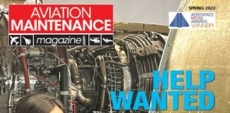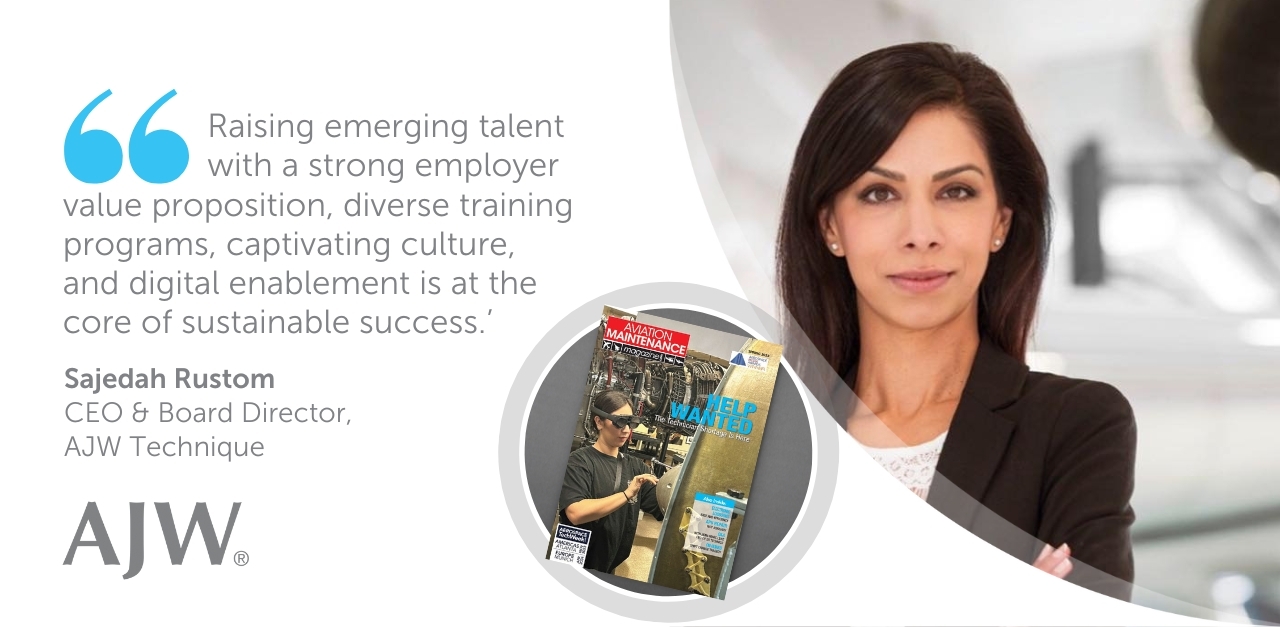

24/7 AOG Critical Response
Hotline![]() UK +44 1403 798888US +1 877 780 2008
UK +44 1403 798888US +1 877 780 2008
Our award winning global AOG service is manned 24 hours a day, 365 days a year.
Please call +44 1403 798888 or email aog@ajw-group.com.

11 May 2023

Shortage of skilled trades dogs airlines, MROs - is there a way out?
Aviation faces a challenge in hiring mechanics due to covid impacts, retirements coupled with accelerated industry growth. A focus on students in STEM, flexible training, employer value proposition, culture, innovation, and operational excellence is key.
In the spring edition of Aviation Maintenance Magazine, James Careless speaks to CEO & Board Member AJW Technique, Sajedah Rustom, and other members of the aviation industry to discuss the challenges and positive measures that can be taken to grow and excite the maintenance workforce.
Careless kicks off by quoting statistics issued by management consulting firm Oliver Wyman, with 2027 ‘projected to be the worst year for the shortage.’ The outlook and predictions have been on the cards for some time, according to a representative from Oliver Wyman, who says that valuing and implementing more diversity would go a long way to improve the bleak-looking future.
Surveys conducted at aviation maintenance schools also reported such shortages and many employers are struggling to find skilled technicians for their workforce. Charles Horning, Director of Regulatory Compliance and Outreach at Embry-Riddle Aeronautical University (ERAU) in Daytona Beach, Florida, says these shortages span the entire industry and businesses are increasing wages to draw more people into their operations as demand for technicians has risen in recent years.
The article mentions that although there are many causes, there are also many solutions that can be addressed to alleviate the current and forthcoming challenges within the industry. The first reason cited as a cause for the technician shortage is the retiring of ‘baby boomers’ due to Covid 19. ‘When the COVID-19 lockdowns happened, many mechanics and technicians left the industry – they have not returned,’ comments Armel Jezequel, Director General/COO at Vallair.
According to Crystal Maguire, ATEC Executive Director, the average age of aviation technicians is 51, and many are over 64, which does not bode well for the coming decade. The increased and growing demand for air travel sees industry stakeholders smiling but also leaves them anxious as to how to continue operational growth with dwindling numbers of skilled technicians.
Sajedah Rustom comments on the predicted fleet expansion in the North American region, and the immense growth in regions such as China, saying, ‘This is because airline flight schedules are increasing as travellers take to the skies.’ Rustom is optimistic about business opportunities for AJW Interiors as, ‘many airlines are also expanding their fleets and mission profiles, and actioning previously neglected interior refurbishments and delayed maintenance scheduling.'

Another reason the industry is experiencing labour hardships is due to the insufficient number of people being recruited into the field. ‘At the height of COVID, there was a reduction in the number of aerospace technicians being trained and this shortage put pressure on the aviation supply chain,’ notes Rustom. Careless notes several reasons why enrolment numbers are down, including public stigma around blue-collar trades/careers, and Horning offers his opinion that convincing the public that a career in aviation maintenance is a good career choice is what is needed. Other experts agree and explain that communication around careers within the industry may be the key to mitigating problems going forward.
The article discusses social beliefs surrounding the industry and why the stakeholders need to work with the trends and desires of Generation Z (Gen Z) if they are to attract more talent. Working with educational institutions and schools from the ground roots up will slowly change opinions about career paths in maintenance. Careless continues with insight about what is being done to change the way training is conducted, utilising innovative technologies, and looking to make these careers more lucrative, and thereby more attractive, to the more digitally focused Gen Z members.
In closing, the article’s author notes that it is important to retain technicians who are already in the industry and offer solutions to keep them engaged so as not to lose them sooner than necessary. The process will be slow, but it is certainly achievable he affirms.
Rustom offers closing insights suggesting that offering flexible working solutions to seniors verging on retirement will ensure the technical foundation of the business is strong and says,
‘Raising emerging talent with a strong employer value proposition, diverse training programs, captivating culture, and digital enablement is at the core of sustainable success.’